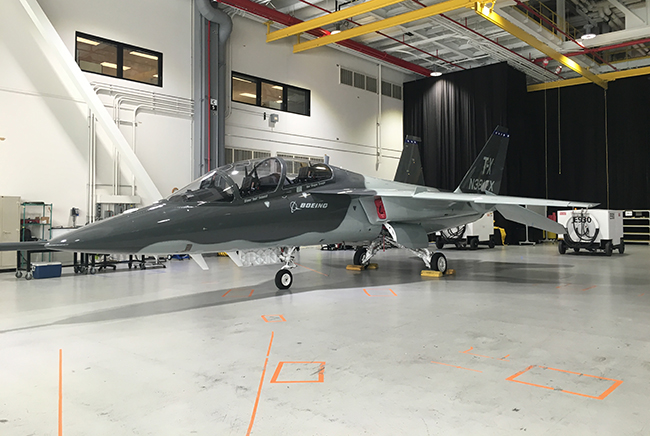
A T-X advanced trainer is shown at Boeing's St. Louis, Mo., facilities on May 14, 2019. Staff photo by John A. Tirpak.
Boeing sees a potential market for up to 2,600 of the T-X advanced trainers in variants ranging from trainer to light strike and light fighter, said William Torgerson, senior director of T-X program integration at the company.
That includes the “up to 475” jets the Air Force asked for in the T-X competition, which focused only on the trainer mission and not variants for other USAF missions now or previously performed by the 60-year-old T-38, which the T-X will replace, Torgerson said. Those missions have also included Aggressors and companion trainers.
Torgerson spoke at a factory tour for the media at Boeing’s St. Louis, Mo., facilities, where the T-X will be produced. His briefing was the first for the media since Boeing won the T-X contest. Boeing furnished travel and accommodations to press covering the event.
Boeing is facilitizing to build up to 48 jets a year for the Air Force, but can increase the rate to 60 if the Air Force wants to accelerate the program in some years, or if there are foreign sales, Torgerson said.
Depending on the potential customer country, either Boeing or Saab, its T-X partner, will head up the capture effort, Torgerson explained, suggesting Saab will take the lead when the customer country already operates Saab’s JAS-39 Gripen fighter. Saab announced last week it will build its portion of the T-X in West Lafayette, Ind. While he would not give too much detail about the workshare between the companies, Torgerson said that, broadly, Saab will build the rear fuselage, starting at a “break point” immediately behind the tandem cockpit. Boeing will build the wings, empennage, and the forward portion of the T-X.
Torgerson said the T-X should do well in international sales, because “no one can compete with our price” on a comparable jet, noting the Air Force has said Boeing’s proposal “saved them $10 billion.”
For commonality and cost, the T-X displays are the same as on Boeing’s advanced F-15s for Qatar, which would equip the F-15EX the Air Force requested in its fiscal 2020 budget. The touch-screen system requires no special gloves to function.
The two aircraft Boeing built for the T-X competition were used to generate flight data required by the Air Force, Torgerson said. They were not prototypes, he noted, because that was not required. For example, although space was left for an aerial refueling system, the two competition airplanes were not plumbed for it. However, he described the contest aircraft as ready for engineering, manufacturing and development, meaning they can continue to fly, generate data, and prove out software as the Air Force and Boeing together refine what the service wants the T-X to do. Flight operations will resume “imminently,” Torgerson said. The first T-X flew 71 times during the contest, while the second jet flew 15 times. To demonstrate their reliability, they were flown up to four times a day during the competition, “which is how the Air Force is going to use them,” he noted.
Boeing is to provide initial aircraft to pilots at JBSA-Randolph, Texas in 2023 and initial operational capability for the T-X is planned for 2024. The Air Force and the aircraft are “learning each other,” he said, explaining that the Air Force is developing ways to exploit the full capabilities the T-X offers.
The T-X will largely be an aluminum airplane, Torgerson told Air Force Magazine, and the only composite structure on the jet will be the nose. A metal airplane is easier to manufacture and easier to repair, he said, and the use of lighter-weight materials wasn’t a requirement as “we didn’t have to squeeze every speck of performance” out of the design, given that it’s not intended to be a front-line combat airplane. Even so, the T-X is described as having the ability to pull more than 8Gs.
Boeing is developing all training software simultaneously with development of the jet. The plan is to eliminate the latency that typically afflicts simulators when a new operational flight program is released to the fleet. Whatever software build is running on the airplane will also be in the simulator, at the same time, Torgerson reported. Boeing is to build and provide at least 46 simulators under the T-X contract and the Air Force has options for a total of 120. There will also be part task trainers and desktop-type computers and controls to help pilots learn switchology and operations of the various “apps” on the T-X.
Torgerson said children were invited to play with the T-X desktop system and reported that it was “like an iPhone” and intuitive to operate. The “apps” approach was taken to make adding functions easier on the open-system architecture aircraft, without the need to restructure the operational flight program for each change. The pilots who train on the T-X will have grown up finding such an approach natural, he said.
The design of the T-X was also made with maintenance as a key factor. The airplane has a high wing to facilitate movement underneath, and Torgerson said no tools are needed to open the most frequently used access panels. The landing gear, which is built by Collins, is the same as that on the F-16, except the nose gear retracts forward instead of back.
“Why develop something that already exists?” Torgerson said. The T-X will, however, have an all-new and “advanced” on-board oxygen generation system, to take advantage of lessons learned in recent years from problems in other aircraft types.
